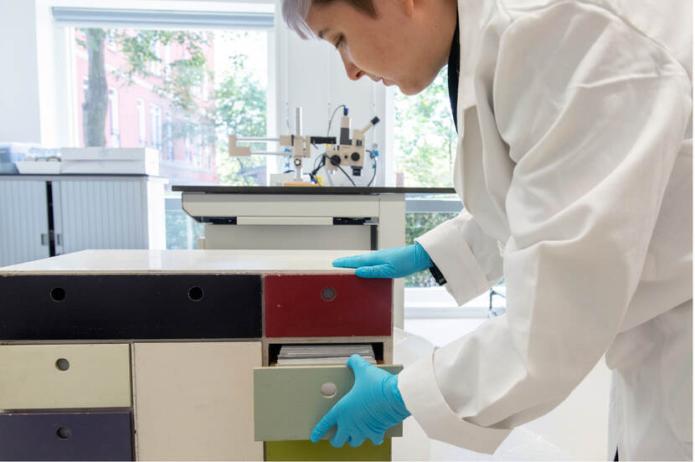
Modern art and architecture – forever young?
To date, there have been few concerted efforts to preserve our modern heritage. While 17th-century paintings and medieval monuments can still be seen and admired, it’s not clear if art and buildings made in the 20th century will survive for future generations. Post-war heritage is particularly at risk. Little is known as yet about the durability and lifespan of materials used to create them. To address this, the Cultural Heritage Agency of the Netherlands (RCE) has launched a new programme: ‘20th-century Heritage: a future for the recent past’.
As the world around us changes, efforts to ensure the preservation, management and presentation of heritage of the 20th and 21st centuries also face new challenges. Heritage from earlier periods has proved it is possible for materials to survive, that effective management and preservation are crucial and that, on the whole, management practices are excellent. Not so with modern art and cultural production. Art objects, buildings and industrial structures made in the 20th century, and especially after 1945, are at risk because they use modern materials and because their cultural value is still underappreciated. This has led to serious questions from policymakers, heritage professionals and the public.
Urgent questions
We believe in the importance of understanding, appreciating and treasuring our heritage from the recent past. This may seem obvious, but also creates risks. Museums and other heritage institutions strive to make modern heritage accessible to wide audiences. Sometimes, with adverse effects on the material preservation of the objects concerned. In architecture and the restoration of existing buildings, the energy transition is making it imperative to use sustainable processes and materials. But will the substitution of original materials mean a loss of cultural qualities? And how much greater are the dangers of neglect and degradation if heritage is recognized too late?
We believe in the importance of understanding, appreciating and treasuring our heritage from the recent past. This may seem obvious, but also creates risks. Museums and other heritage institutions strive to make modern heritage accessible to wide audiences. Sometimes, with adverse effects on the material preservation of the objects concerned. In architecture and the restoration of existing buildings, the energy transition is making it imperative to use sustainable processes and materials. But will the substitution of original materials mean a loss of cultural qualities? And how much greater are the dangers of neglect and degradation if heritage is recognized too late?
Knowledge, artists and potential
To properly care for and support the potential of modern Dutch heritage, we need knowledge. At present, that knowledge is scattered or underdeveloped. Thorough analysis of the most urgent questions and future prognoses requires understanding the objects, as well as knowledge of historical and modern-day materials and techniques and of the influence of restoration interventions and environmental factors such as light, temperature, damp and grime. The key is the artist or architect, and attempting to understand which materials they used, and how.
To properly care for and support the potential of modern Dutch heritage, we need knowledge. At present, that knowledge is scattered or underdeveloped. Thorough analysis of the most urgent questions and future prognoses requires understanding the objects, as well as knowledge of historical and modern-day materials and techniques and of the influence of restoration interventions and environmental factors such as light, temperature, damp and grime. The key is the artist or architect, and attempting to understand which materials they used, and how.
Programme on 20th-century Heritage
In the 2021-2023 period, the RCE will bring together the aforementioned questions and knowledge in the 20th-century Heritage Programme in order to build specific knowledge and expertise about the production, application and ageing of modern materials. This will make it possible to develop tools and methods keyed to the most effective conservation and preservation of objects and materials. The programme will also seek to advance public appreciation for recent cultural heritage, thus contributing to its significance, protection and use.
Subprojects will zoom in on specific materials, their characteristics, composition, use and conservation, focusing on plastics, photographic material, modern building materials (1945-2000), colour use in built heritage (1940-1980) and painting surfaces by the artists Mondrian, Appel and Schoonhoven. In addition to this material-technical research, an oral history subproject will consult the most primary sources by means of interviews with artists, architects, manufacturers and other makers.
By, for and with whom?
The Cultural Heritage Agency is conducting this programme in close collaboration with The Foundation for the Conservation of Contemporary Art (SBMK), universities (including TU Delft and the University of Amsterdam), museums (including Museum Boijmans van Beuningen, Kunstmuseum Den Haag and the Kröller Müller Museum) and other knowledge institutions, heritage professionals and industrial archives.
The Cultural Heritage Agency is conducting this programme in close collaboration with The Foundation for the Conservation of Contemporary Art (SBMK), universities (including TU Delft and the University of Amsterdam), museums (including Museum Boijmans van Beuningen, Kunstmuseum Den Haag and the Kröller Müller Museum) and other knowledge institutions, heritage professionals and industrial archives.
The programme also has ties with the European Research Infrastructure for Cultural Heritage (E-RIHS)-NL and the Netherlands Institute for Conservation, Art and Science (NICAS), in which the RCE is a key partner. Where possible, the 20th-century Heritage programme will also work with others such as the RCE Heritage and Sustainability and FARO programmes, and various built heritage projects.
For further information about the 20th-century Heritage Programme, visit www.cultureelerfgoed.nl.
For additional information, please contact Anne Houk de Jong, RCE communication advisor
(+31(0)6 2726 8904), a.h.de.jong@cultureelerfgoed.nl, or Klaas Jan van den Berg, programme leader (+31(0)6 1587 9370), k.van.den.berg@cultureelerfgoed.nl.